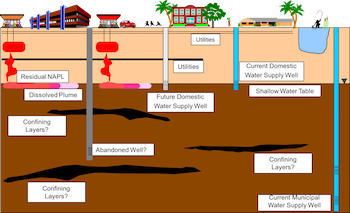Contaminant Fate and Transport Processes

Continuing Education Credits
The CT State Board of Examiners of Environmental Professionals (LEP Board) has approved this course for 8.0 hours of continuing education credits - CTLEP-431. We have applied for CECs in MA and will post when decision is made.The MA LSP Board has approved this course for 8.0 hours of Technical credits (LSP Course Number: 1527a).
Time and Location
This seminar will be held on Monday, May 1, 2017 and runs from 8 AM - 5 PM at the CTCPA Education Center, 716 Brook St., Ste. 100, Rocky Hill, CT. For directions, see: http://www.ctcpas.org/Content/About/Driving-Directions.aspx
Instructor
Dr. Atul M. Salhotra (see bio below)
Course Fees
EPOC Members: $300, Non-members: $350, Gov't Employee/Students : $150
Continental breakfast, lunch, and PM snack included.
Course Overview
This one-day course presents comprehensive information on fate and transport processes and modeling of chemical contamination in soil, groundwater, and soil vapor. This course offers an understanding of basic fate and transport principles and a quantitative analysis of field data. The course will present:
- Basic concepts,
- Fate and transport processes,
- Various commonly used models,
- Underlying assumptions of models,
- Application of fate and transport modeling in site assessment, risk assessment, and risk management.
Hands-on calculations will be required for each of the processes to improve understanding. Throughout the course site-specific examples and case studies will provide practical insights into fate and transport processes involved and relevant modeling applications.
After attending this course, you will be able to:
- Perform a variety of fate and transport calculations
- Understand the basics of used models
- Understand the uncertainties inherent in the application of models
Seminar Agenda/Topics
- 8:00 AM: Objectives of the Course
- 8:30: Basic Concepts and Definitions
Volumetric Properties
Gravimetric Properties
Concentrations
Partition Coefficients
Measurement Techniques
Hands-on Calculations
- 10:15: Break
- 10:30: Basic Processes Simulated by Models
(Qualitative and Quantitative Understanding, and Practical Implications)
Advection
Diffusion
Dispersion
Hands-on Calculations
- 12:00 PM: Lunch
- 1:00: Basic Processes Simulated by Models (Qualitative and Quantitative Understanding, and Practical Implications)
Adsorption
Biotransformation (Solvent & hydrocarbons)
Hands-on Calculations
- 2:30: Break
2:45: Evaluation of LNAPL Data
Thickness in wells
Transmissivity measurements
Hands-on Calculations
- 4:00: Commonly Used Models
Vadose zone
Groundwater
Ambient air
Indoor air
Difference between analytical and numerical model
- 5:00: Adjourn for the day
Participants are requested to bring calculators.
Instructor Bio
 Dr. Atul M. Salhotra is an internationally recognized expert in the cost-effective management of contaminated sites. His expertise and opinions are sought after and trusted by regulators, industries, and the courts by virtue of his having developed risk based decision making programs for the management of chemically impacted sites for more than 15 states. He is the lead author, project manager, and developer of Risk-Based Corrective Action (RBCA) programs for numerous states, and the U.S. Air Force in Europe (USAFE). As one of the original nine ASTM certified trainers for RBCA, he has conducted training courses in over 25 states and 10 countries. Over 6,000 individuals have attended his courses and benefited from the training received.
Dr. Atul M. Salhotra is an internationally recognized expert in the cost-effective management of contaminated sites. His expertise and opinions are sought after and trusted by regulators, industries, and the courts by virtue of his having developed risk based decision making programs for the management of chemically impacted sites for more than 15 states. He is the lead author, project manager, and developer of Risk-Based Corrective Action (RBCA) programs for numerous states, and the U.S. Air Force in Europe (USAFE). As one of the original nine ASTM certified trainers for RBCA, he has conducted training courses in over 25 states and 10 countries. Over 6,000 individuals have attended his courses and benefited from the training received.
Dr. Salhotra is well versed in the site-specific application of risk assessment, evaluation of indoor vapor intrusion, natural attenuation, and fate and transport modeling for the cost- effective management of sites. He has supervised over 200 risk assessments under state and federal programs involving hydrocarbons, solvents and metals, and has successfully defended the results with regulatory agencies and other stakeholders across the country.
Dr. Salhotra has provided litigation support, including testimony in courts, on numerous high-profile projects related to the migration of plumes under people’s homes, the allegation of adverse health effects due to vapor intrusion, and diminution of property values. Several of these projects involved public meetings, risk communication presentations, and media coverage.